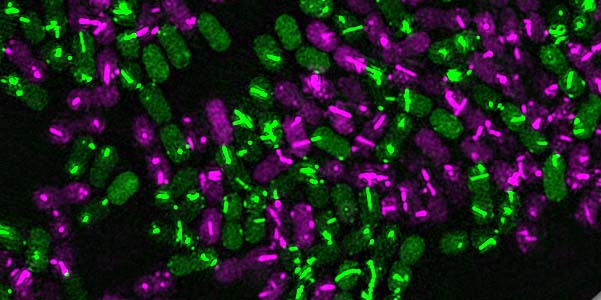No matter where you go, you always find someone there already. This is true for many living creatures but especially for bacteria. In order to be able to stand their ground and eliminate unwanted rivals, many bacteria rely on a sophisticated weapon: the Type VI secretion system, known as T6SS for short. With this nano-sized speargun they inject a deadly cocktail of toxins into their competitors, putting them out of action.
Precise positioning of nano-speargun
In the past years, Prof. Marek Basler and his team at the Biozentrum of the University of Basel have already uncovered many important aspects about the assembly, mode of action and the use of the bacterial nano-speargun. In their current study, which recently appeared in the EMBO Journal, the scientists were able to demonstrate that certain bacteria do not simply fire their weapon aimlessly.
“When they come into contact with a neighboring cell, regardless if they are under attack, the bacteria quickly position their nano-speargun exactly at the contact site and inject a cocktail of toxins,” says Basler. “The good ‘sense of touch’ of the attacker and the precision of the T6SS injection apparatus really impressed us.”
Efficient use of nano-machine
Like a speargun, the T6SS is assembled from various components. These include a spring, a spear with a sharp tip, as well as a baseplate, which firmly anchors the nano-machine into the bacterial envelope. Hundreds of proteins as well as a cocktail of toxins are required for the construction of the T6SS. Thus, it is quite costly for the bacteria to produce the speargun with ammunition.
Many bacteria including bugs like the cholera pathogen haphazardly deploy their nano-speargun. “The random assembly and undirected firing of the speargun, which may not even hit the target cell at all, seems like a waste,” says the first author Dr. Lin Lin. “Precise localization and accurate timing increase the probability of really striking the enemy and improve the cost-benefit ratio.”
T6SS assembly only after contact with the rival
“The Acinetobacter species and Burkholderia thailandensis we studied, whose close relatives cause serious infections in humans and animals, also fire their nano-spearguns blindly into the environment,” emphasizes Lin. “Yet, in contrast to other bacteria, they can also precisely localize and aim their weapon. They ‘feel’ when they touch a neighboring cell.”
Exactly at this contact site, they assemble their speargun within seconds, push the spear into the rival’s membrane and deliver the toxic proteins. In this contact-dependent T6SS assembly, a newly described periplasmic protein as well as the membrane protein OmpA play a key role. Once in position, the T6SS fires several times to increase the impact and thus leaving little chance for the victim to withstand the attack.
Targeted attacks are a much more efficient strategy to get rid of competitors and conquer new ecological niches. “This is certainly an advantage in the competitive struggle with other bacteria,” believes Basler.
Original article:
Lin Lin, Raffaella Capozzoli, Alexia Ferrand, Miro Plum, Andrea Vettiger, and Marek Basler. Subcellular localization of Type VI secretion system assembly in response to cell-cell-contact. EMBO Journal, published online 30 May 2022
Contact: Communications, Katrin Bühler



